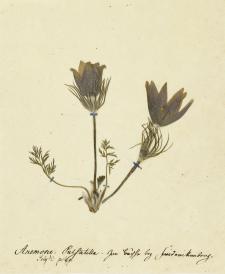New joint project researches the plant collections of the Moravian Church in the herbarium of the Dresden University of Technology

The Moravian Church, founded in the Saxon town of Herrnhut in Upper Lusatia, is a global missionary movement, which, through its worldwide expansion, illustrates the close connection between Christian mission and colonialism. In the 18th century, its members were also botanically active as outstanding observers and left behind floras and herbarium specimens of great importance for today's botany. The oldest natural collection of the Moravian Church was created in Barby, a small town in Saxony-Anhalt, from 1750 onwards. Of these, the Herbarium Barbiense with 1,260 plant specimens is preserved in the Herbarium Dresdense. The specimens were worked on with Carl von Linné, among others, and, together with duplicates in other herbaria, attest to the close networking of the Moravian naturalists with important scholars of their time. From the 19th century, there are a further 5,000 specimens relating to the Moravian Church in Dresden herbarium.
In the current joint project "Natural Science and Protestant Mission", the scientists of the Chair of Botany at the Dresden University of Technology, in cooperation with the Interdisciplinary Centre for Pietism Research at the MLU, would like to identify these documents and make them digitally accessible. The digital representation of the botanical network using digital humanities methods, as well as the creation of an expandable digital lexicon of all persons active in natural history in the Moravian Church, will also serve as a basis for other natural science collections to contextualise their holdings.
"In the process, it will also become clear what significant influence religious communities and Christian missionary activities had on the establishment of modern natural sciences through their extensive collections of materials. This opens up a perspective on a hitherto completely neglected group of people: not only on the few already famous botanists, but on the simple craftsmen and missionaries in the sometimes very remote mission stations as well as their wives, indigenous helpers and assistants, and pupils at the foreign mission schools or the high schools of the Moravian Church," says Dr Thomas Ruhland, principal investigator of the project at the Interdisciplinary Centre for Pietism Research at the MLU, explaining the significance of the research project.
Through the indexing and extensive botanical and cultural analysis of the herbarium specimens, the joint project illustrates the great potential of university collections. It demonstrates how digitisation and network analysis enable different perspectives and points of view on the same collection and can thus constructively bring together and answer fundamental research questions of the natural sciences.
Dr Sarah Wagner, principal investigator of the project at TUD, hopes that the project will also increase the visibility and appreciation of the Herbarium Dresdense: "The joint project reveals the value of our herbarium as a scientific university collection and enables unique insights into hardly examined subcollections. Besides the Saxonian plant diversity of the past 250 years, the botanical achievements of many generations of researchers are documented and archived. The methods and techniques of collection conservation and management developed in the project are urgently needed for the continued existence of the Herbarium Dresdense and are to be transferred to the entire collection after the end of the project."
The scientists from Halle and Dresden are supported by the Saxon State and University Library (SLUB) and the Senckenberg Museum of Natural History Görlitz, as well as by the Moravian Knowledge Network (MKN), which has established itself in recent years. Valuable preliminary work for the now approved project was achieved thanks to the support of the Gesellschaft der Freunde und Förderer der Technischen Universität Dresden (GFF).
The project "Natural Science and Protestant Mission" is one of six funded interdisciplinary research collaborations within the framework of the BMBF funding guideline: Networking - Accessing - Researching. Alliance for University Collections II. In addition, a BMBF-funded accompanying project, which is based at the Coordination Office for Academic University Collections, supports the collaborative project in realising the project goals.
More information: https://tu-dresden.de/mn/biologie/botanik/forschung/herrnhut

